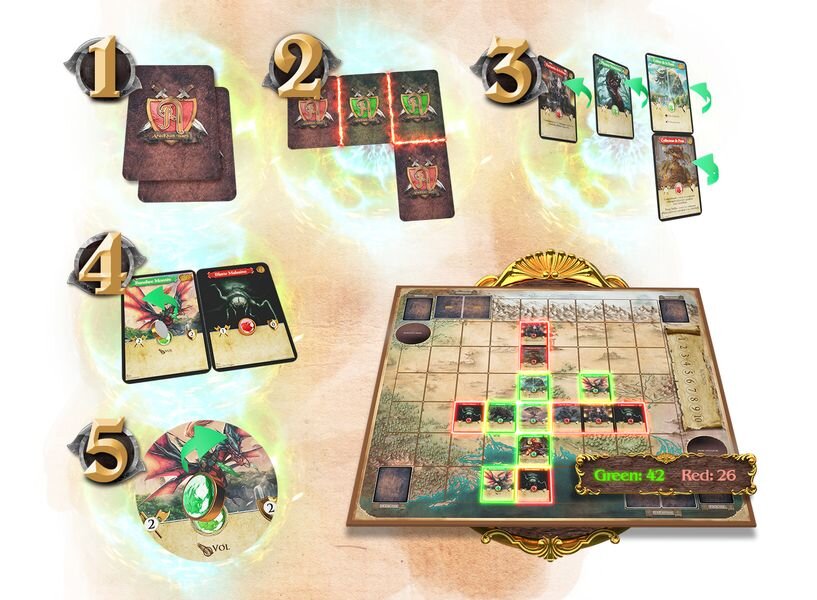AracKhan Wars – First Impressions
Coming to Kickstarter on June 8th, AracKhan Wars is a strategic card game based on the Arackhan fantasy setting. It’s designed by Bob Palmer and Mickaël Bour, with detailed artwork that brings to life the four distinct Provinces that compete in an epic battle on the table.
It’s a tactical skirmish game that relies on decks with point maximums, so players will have to devise the best strategy with the combinations they include in the 23-card deck.
There are some unique elements to this deck-dueling card game, though, so don’t assume anything with AracKhan Wars. This is a contest of the mind just as much as the sword.
And the player with the highest value at the end of the game will win.
Alex from BoardGameCo and I have a healthy competitive nature when it comes to the games that we play with each other, so it’s always satisfying to engage in a 1v1 struggle. Our Provinces battled and one came out on top (better luck next time, Alex), but along the way, what did AracKhan Wars do right?
What It Does
Four factions—Provinces of Arackhan—will clash on the battlefield. Two at a time, of course. It would get a little messy if everyone jumped in the fray all at once.
Players will decide what cards from the deck will appear in the game. 23 cards are chosen with a maximum point value of 125. That forces a limit on each player who must determine which cards are better suited for the fight at hand.
Then, over the course of nine rounds, opponents will alternate placing and activating units on the map. With group attacks, penetrating damage, ranged enemies, and tactical auras to exploit, there are a lot of possibilities for players to consider.
Realize, though, that this isn’t an incremental slog across the battlefield, inching forward into no man’s land before confronting the frontline of the enemy. It’s not a gradual push. It’s a heavy hammer blow right to the temple from the outset. AracKhan Wars encourages you to start the fight with a sword in hand rather than a salute to the enemy.
After all, manners are for those who aren’t going for the kill…
How It Does It
Let’s start with the battlefield. It’s the most significant aspect of gameplay in AracKhan Wars because of how it subverts expectations for a grid-based map in a a two-player card game.
There isn’t a deployment area (outside of the four central green slots where the game begins). Everywhere is open for unit deployment, as long as it’s adjacent to an existing card on the map.
That creates a lot of freedom… and a lot of danger. After those four units are placed by players in the first round, subsequent deployments can happen adjacent to any other card, including an opponent’s. So, you can be surrounded. Or you can be the one overwhelming. Or an entire flank can get wiped out in one turn. Or you can cut your opponent’s forces in half. Or or or or…
Instead of a standstill in the middle of the battlefield, the spatial arrangement of the conflict will morph like blood in the rain, pooling into different splotches of tense combat.
And though there are a high number of rounds, the game plays out fairly quickly. Players will draw their cards, position them on the field, reveal them, activate them, and then resolve the movements, attacks, and deaths of all relevant units.
The spatial permutations at play in the gameplay design of AracKhan Wars, however, require you to ditch some of the strategic presumptions that many players bring to tactical skirmish games and competitive card games.
You can’t necessarily build an engine of defensive prowess and then spur on rapid offensive growth from a position of safety. You can’t trudge forward until you slam into the fantasy equivalent of the enemy’s shield wall.
Rather, you must anticipate attack from every angle. You need to expect losses from angles you didn’t consider or from abilities you can’t block. And, with all of that potential energy surging around your forces, you must direct as much of it toward your opponent as possible. Rout their isolated units. Cut their defenses to ribbons. Separate their Landmarks from their forces. All while mitigating danger to the units that are scattered across the map.
Why You Might Like It
There is an intensity with which AracKhan Wars plays. The chance that your units could be slaughtered or that your offensive maneuvers could be dismantled in ways different from other games creates a palpable tension in the air. It’s more engaging than some other games with a similar surface-level design.
The four factions have very different strategies regarding combat and it would be satisfying to pit all of them against each other and discover ways to deconstruct and destroy one faction using the strengths of another.
Why You Might Not
Even with fairly even decks of units, landmarks, and auras, it’s possible that a player could get a much better draw than an opponent and develop an early edge that’s hard to overcome.
I’d have to play more to experience it myself but it’s possible that AracKhan Wars could have factions that win over others on too frequent a basis for the fight to feel as fair as another pairing.
Final Thoughts
AracKhan Wars has a lot going on that interests me. I played with a prototype copy, so I’d be interested to see how the final production copies and Kickstarter extras enhance the feel of the game and the longevity of play.
The spatial puzzle that originates from the central deployment mechanism definitely intrigues me as it opens up a lot of tactical nuances that don’t always exist in head-to-head card games.
And the factions, if balanced correctly, could really create a fun atmosphere for players to explore as they discover the strongest combinations betweens cards in the deck. The units, landmarks, and auras also contribute to the variability at play in combat.
As of now, I want to see more. I want to study the factions in-depth and see what other players are able to accomplish when testing out strategies with certain cards. The broad scope of tactical choices gives me hope that this could be a good medium-light card game to bring out when you want to bash in the head of your opponent. But their figurative head that’s manifested in the forms of fantasy creatures on the board in front of you. Not their real head…
If you want to check out AracKhan Wars, you can visit the website or read what the community thinks on BoardGameGeek.
Have you played a strategy card game like AracKhan Wars? What other tactical games do you like?
Let us know in the comments and give a recommendation for other games of which to share our first impressions.





